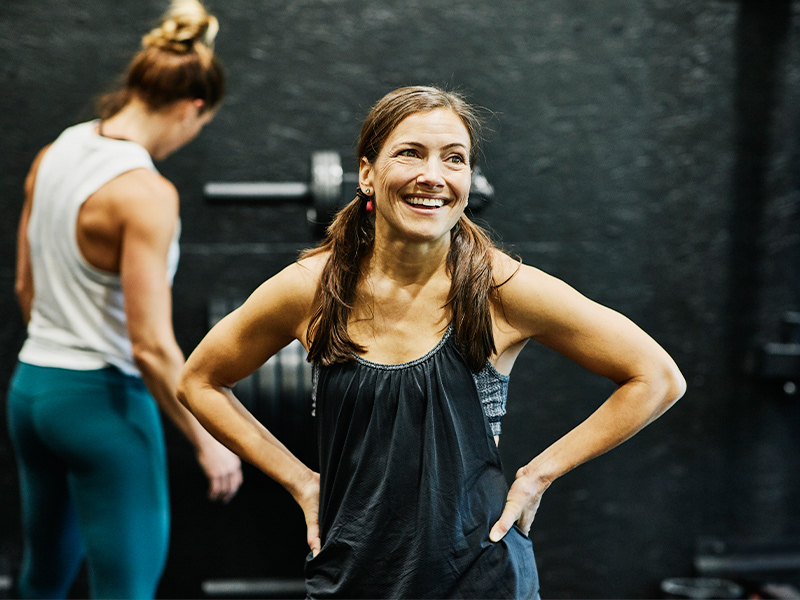Fit, fabulous and 40-plus: How to get in the shape of your life
It’s never too late to start exercising. In fact, research shows that – for women especially – finding fitness over 40 could be the perfect time to adopt healthy lifestyle changes.
Only one in four Australian adults meets the official physical activity guidelines by doing enough exercise, with the right mix of activities, each week.
If you’re among the three in four who don’t, and you’re in your forties and worried you’ve left it too late, there’s good news.
A 2019 study shows that starting regular exercise at any age delivers health benefits – even for people in their 70s who hadn’t exercised much in the past.
Then there’s research released in early 2022 that shows that for women, perimenopause – which usually starts in the mid-40s – is one of the best times to make healthy lifestyle changes.
Why finding fitness over 40 is the perfect time to ‘get healthier’
Interestingly, the study found that the body composition changes typically linked with menopause and beyond – including fat gain, muscle-mass loss and the tendency for weight to gather around the stomach – actually begin during perimenopause.
The researchers say it means lifestyle interventions to minimise these changes may be most valuable then too, especially given that these same changes contribute to the increased risk of heart disease, type 2 diabetes and osteoporosis that women experience post-menopause.
“The sooner you begin to build strength in your muscle and bones, the better – think of it as future-proofing your body,” menopause fitness coach and Owning Your Menopause founder Kate Rowe-Ham says.
“It’s also important to look at how you’re nourishing your body with food and rest,” Kate adds.
5 ways to find fitness over 40
Whether it’s been a while since you worked out or you’re brand new to it, here’s how to shape up once you’ve hit the big four-oh:
1. Be prepared to stretch your mindset
“It really is never too late to make progress in your fitness routine,” Kate says.
“But it can be difficult to change your mindset if it’s been a while since you’ve exercised, or if you’re just starting out.
“We can also feel overwhelmed and confused about how to begin, which acts as a barrier.”
As a starting point, think about what you want to achieve and how to get there sensibly, Kate suggests, and don’t place unrealistic expectations on yourself.
“The most important thing is to start slowly,” she says.
2. Do what feels good
“Many women I see are still set on using high-intensity interval training for fat loss, but this isn’t a time to be adding extra stress to your body,” Kate says.
“Women often think that high-impact sessions will have more benefit, but they can just leave us more prone to injury.
“Instead, this is a time to listen to your body in order to maximise results, especially as we’re often juggling so much at this life stage.”
3. Add some weights
As well as doing yoga or pilates, Kate encourages women discovering fitness over 40 to add weights to their workout week if they aren’t lifting already.
Guidelines recommend doing weight training at least two times a week, and research backs up the importance of regular strength training for women around menopause, finding it builds and maintains muscle mass, as well as helps to prevent weight gain and increases in body fat levels.
- Strength training: Why resistance work may be the secret to burning fat
4. Prioritise protein
Protein is the building block of lean muscle tissue – and according to new research from the University of Sydney’s Charles Perkins Centre, eating more of it during perimenopause may ward off weight gain.
“The evidence suggests that staying on the typical highly processed Western diet during the transition to menopause at around age 40 to 50 will result in excess energy intake, leading to weight gain and increased risk of obesity and cardiometabolic diseases,” study lead author and Charles Perkins Centre academic director Professor Stephen Simpson says.
“However, the good news is that it appears very small changes to the diet in terms of prioritising protein, reducing fats and carbohydrates, and being physically active could make a big difference in the long term,” study co-author Professor David Raubenheimer adds.
Increasing the amount of protein you eat by just three per cent of daily energy intake and lowering total daily energy intake by five to 10 per cent may be sufficient to have a positive effect.
“For many, cutting out a bag of crisps, or a glass of a sugar-sweetened beverage or equivalent, and ensuring that high-quality animal or plant protein is in the daily diet will do the trick,” Prof Simpson says.
- The right source: Animal vs plant protein – what’s better for you?
5. Avoid the ‘time trap’
Kate says exercise often falls by the wayside because we feel time-poor.
“But if you can find just 30 minutes, five days a week, you will make progress!”
- Juggling act: Top time-management tips for busy women
Written by Karen Fittall.





